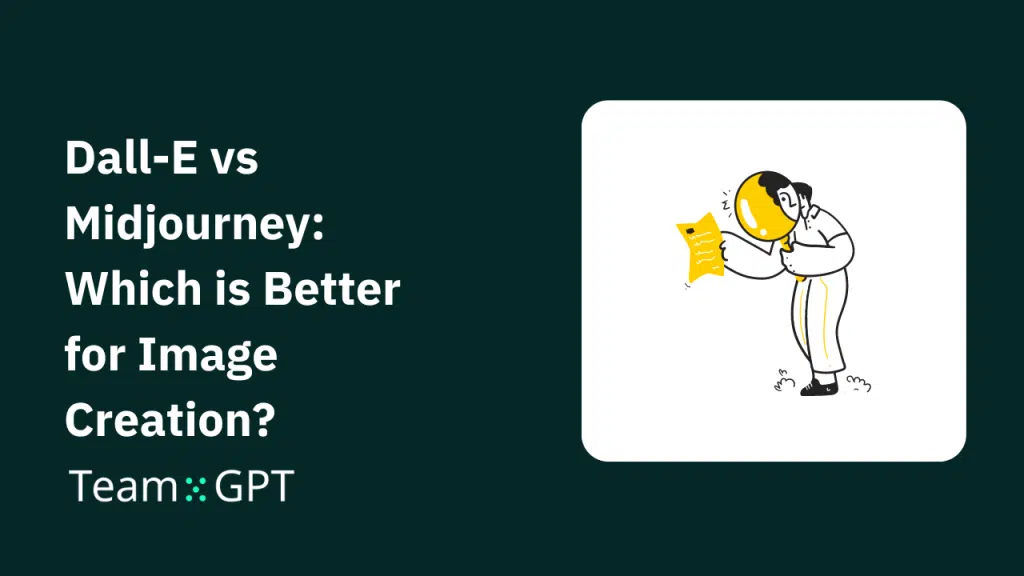The question we’re trying to answer with this article is: Dall-E vs Midjourney, which one’s better?
Short answer: Both tools have their own strengths and weaknesses.
To know which tool is better than the other in specific use cases and features, read the article.
We start by explaining the main feature differences between Dall-E and Midjourney and then discuss their pricing, use cases, and limitations.
Midjourney vs Dall-E: What are the Differences?
In this section, we will cover all the major differences between Midjourney and Dall-E.
- Image quality
- Artistic styles
- Image editing
- Text-to-image generation
- Image variation
- Upscaling
- Community and collaboration
Here’s a table that will show you which tool – Dall-E or Midjourney is better in each of the features we mentioned above:
| Feature | Image Generator |
| Image quality | Dall-E |
| Artistic styles | Midjourney |
| Image editing | Midjourney |
| Text-to-image generation | Dall-E |
| Image variation | Dall-E and Midjourney |
| Upscaling | Dall-E |
| Community and collaboration | Midjourney |
To learn more about the difference between Dall-E and Midjouney, read ahead.
1. Image Quality
If we compare image quality, Dall-E is a clear winner. That’s because Dall-E has the capability to generate images of higher resolution, ranging from 1024 X 1024 px to 1536 X 1536 px. The images produced by Dall-E are more detailed, with sharper edges, better textures, and more realistic.
What’s more, Dall-E’s images have better color accuracy and smoother gradients, resulting in more natural and visually appealing AI images.
Lastly, the software excels at rendering complex scenes, intricate patterns, and fine details, such as text, logos, and intricate designs.
Midjourney generates images at a lower resolution, around 1024 X 1024 px. While Midjourney’s images are visually striking, they often lack the crispness and detail found in Dall-E’s output.
Midjourney’s images are sometimes blurred, especially in areas with intricate details or complex textures. This is the reason why the platform performs better with more abstract or stylized prompts, where precise details are less crucial.
To test the image quality, we gave both Dall-E and Midjourney the same prompt.
Here’s the prompt: An ancient library hidden inside a giant tree, illuminated by sunlight filtering through the leaves. Inside, shelves carved into the tree trunk overflow with old, leather-bound books.
Dall-E was able to grasp the image concept properly and gave a stunning image:
Midjourney didn’t understand the concept as well as Dall-E did. The image was also a little blurred, where complex details were needed (as mentioned earlier).
🏆 Winner: Dall-E
2. Artistic Styles
Midjourney excels at producing a wide range of artistic styles, from photorealistic to highly stylized and abstract design. It can generate images that mimic various art movements, such as impressionism, cubism, surrealism, etc.
The tool is particularly adept at creating unique and imaginative styles that blend different artistic elements and techniques. Its outputs range from vibrant and colorful to more subdued and monochromatic styles, depending on the prompt you give it.
Dall-E, on the other hand, can produce decent quality images of artistic style, but its strengths lie more in realistic and representational image generation.
The tool is better at rendering accurate representations of objects, scenes, and environments with a more natural aesthetic.
Dall-E can mimic specific art styles, but its range is more limited than that of Midjourney.
Prompt used: 3d beautiful sensual woman model figure posing one line calligraphy art watercolors.
🏆 Winner: Midjourney
3. Image Editing
Midjourney comes with a spectrum of image editing options, leveraging which you can modify the image in several ways and styles.
You can:
- Adjust lighting
- Change colors
- Blend modes
- Apply filters and effects to the image
The editor in Midjourney allows you to add, remove, and modify specific elements, such as objects, backgrounds, or entire scenes.
What’s more, Midjourney has a remaster feature that enables you to refine and improve image quality by regenerating it with additional prompts and parameters.
Dall-E’s image editing capabilities are a little limited when compared to Midjourney’s. It allows you to make basic adjustments to the image, like cropping, resizing, and applying simple filters but lacks the advanced features that Midjourney offers.
The platform also doesn’t offer features to change or modify specific elements in the image or make significant changes.
🏆 Winner: Midjourney
4. Text-to-Image Generation
Dall-E is better than Midjourney at understanding intricate and detailed text prompts generating highly specific and nuanced images.
The tool effectively breaks down a complex description into a visual as it gives you an image as close as you might’ve imagined.
While Midjourney does a decent job of creating images with text-based prompts, its overall image quality is a little behind Dall-E.
There’s a good possibility that the tool might struggle with complex or technical prompts and generate images that deviate from the intended idea.
To test this concept, we built a complex prompt and gave it to both Dall-E and Midjourney.
Prompt: Chinese landscape painting, blue mountains in the distance, Chinese style architecture on top of mountain, light gray and dark brown, colorful ink wash paintings, meticulous brushwork, colorful woodcut prints, mountains, rocks, clouds, green trees, blue sky, red flag, small house, golden age illustrations, in the style of colorful woodblock print, ultrahigh definition images, wetland scenery.
Here’s what Dall-E generated:
And here’s what Midjourney generated:
🏆 Winner: Dall-E
5. Image Variation
With Midjourney, you get a feature called Image Variations that lets you generate multiple interpretations of the same prompt.
With a single click, you can request anywhere from 1 to 8 variations of the image generated first. Midjorney will generate each image with unique composition, perspectives, and styles.
Dall-E does generate multiple images from the same prompt, but you have to copy and paste the prompt every time you want a variation. This makes the process a little less efficient, but it does the job well.
🏆 Winner: It’s a tie.
6. Upscaling
Dall-E comes with an upscaling feature integrated into the UI so users can easily access it.
For those of you who don’t know, upscaling is a process of increasing the resolution or dimension of an image.
Dall-E’s upscaling gives you higher quality and more consistent results.
All you have to do is tell Dall-E to Upscale the image.
Midjourney also has a built-in Upscale feature that lets you enhance image quality in 4 different qualities. But it takes a lot of GPU time. Midjourney offers limited GPU time for all its paid plans, so the more you upscale images, the less you’d be able to generate images.
🏆 Winner: Dall-E
7. Community and Collaboration
Midjourney has an active community of users who regularly share their creations, give feedback, and collaborate on projects as you get access to Midjourney via. Discord (website access under Beta) is the central hub of this community.
The platform has different Discord servers (groups) for sharing images, techniques, and seeking help.
Dall-E has a community forum where users share their creations, ask questions, and engage. But it’s less active when compared to Midjourney.
🏆 Winner: Midjourney
Dall-E vs Midjourney: Pricing
Dall-E’s pricing is pretty straightforward. When you use it via the GPT-4 interface, you have to pay $20 per month. That’s because Dall-E is part of the ChatGPT Plus subscription.
You can also use Dall-E for free with some Microsoft tools, though the images might have a watermark, depending on the platform you use.
One last way to use Dall-E is via Open AI’s Playground platform, which you can access after logging into your Open AI account.
The platform charges a minimal fee per image generated.
There are no limitations on the number of images you can generate with Dall-E.
Midjourney, like Dall-E, has no free plan, and its pricing starts at $10 per month and goes all the way up to $120 per month.
The $10 per month plan gives you 3.3 hours of GPU time, which means you can create ~200 high-resolution images per month. Editing and upscaling takes extra GPU time, so the more you upscale and edit images, the fewer images you will be able to generate.
Other Midjourney plans give you unlimited creation in Relax mode but have a cap of fast GPU hours.
When Does it Make Sense to Use Each?
Both Dall-E and Midjourney do a great job at producing AI images, but they have slightly different strengths and use cases.
Here’s a list of use cases Dall-E’s best for:
- Generating photorealistic and detailed images that focus on accuracy and realism.
- Creating images with complex compositions and multiple elements.
- Excelling at rendering text and incorporating text elements into images.
- Generating images with a consistent style across multiple generations.
Use Midjourney if you want:
- Artistic and stylized images with surreal aesthetics.
- Generating images with a specific art style or mimicking a particular artist’s techniques.
- Creating highly detailed and intricate scenes, especially in the fantasy or science-fiction genres.
- Exploring more experimental and creative prompts due to its flexible and imaginative nature.
What are the limitations of Dall-E and Midjourney?
While AI image generators make generating images quick and affordable, the process has some downsides as well.
1. Lack of Originality
Since their launch, AI image generators have been criticized for their lack of originality. The AI uses pre-existing data that it has been trained on to generate images.
Although you won’t see an image as it has been generated elsewhere, this still raises questions about its originality.
This issue can also cause legal consequences. If the image generated is too close or identical to existing works, it can result in accusations of plagiarism or copyright infringement.
2. Prone to Biases and Lack of Diversity
The AI image generators are trained on vast data of images that might have social biases, stereotypes, and underrepresentation of certain cultural groups. This can lead to image generation that offends some people in society.
For example, when I asked Dall-E to generate an image of a doctor and nurse, it gave me a Male white doctor and a female white nurse.
Why did the AI assume by a doctor, I meant a male doctor?
And why are both white?
3. Limited Contextual Understanding
While AI image generators produce visually stunning and creative images, they lack a true understanding of the context, meaning, and deeper concepts behind the prompts they receive.
They generate images based on patterns and associations in their training data, but they don’t have a genuine comprehension of the subject matter or the ability to reason abstractly.
Dall-E vs Midjourney Which Image Generator Tool to Use?
Let’s face it: there’s no one winner in the Dall-E vs Midjourney battle. Both the tools excel at specific use cases.
- If you want an AI image generator that lets you edit images, Midjourney is your choice.
- If you want an AI image generator that has a low learning curve and lets you produce images with ease, Dall-E is your go-to choice.
Want to explore Dall-E and generate flawless images? Using it with a platform like Team-GPT makes the whole process a lot easier.
Sign up for the free Team-GPT plan and unleash your creativity for image generation.
Related reading:
- 12 Best Dall-E Prompts to Create Designer Level Images in 2024
- How to use Dall-E-3 to Create Stunning AI Images in 2024



